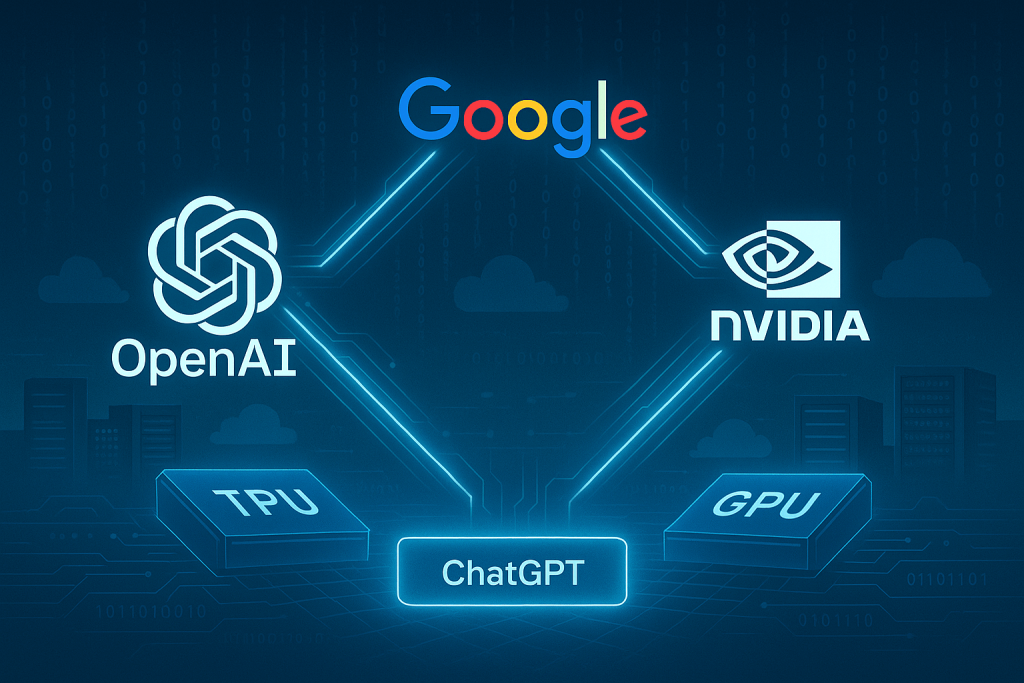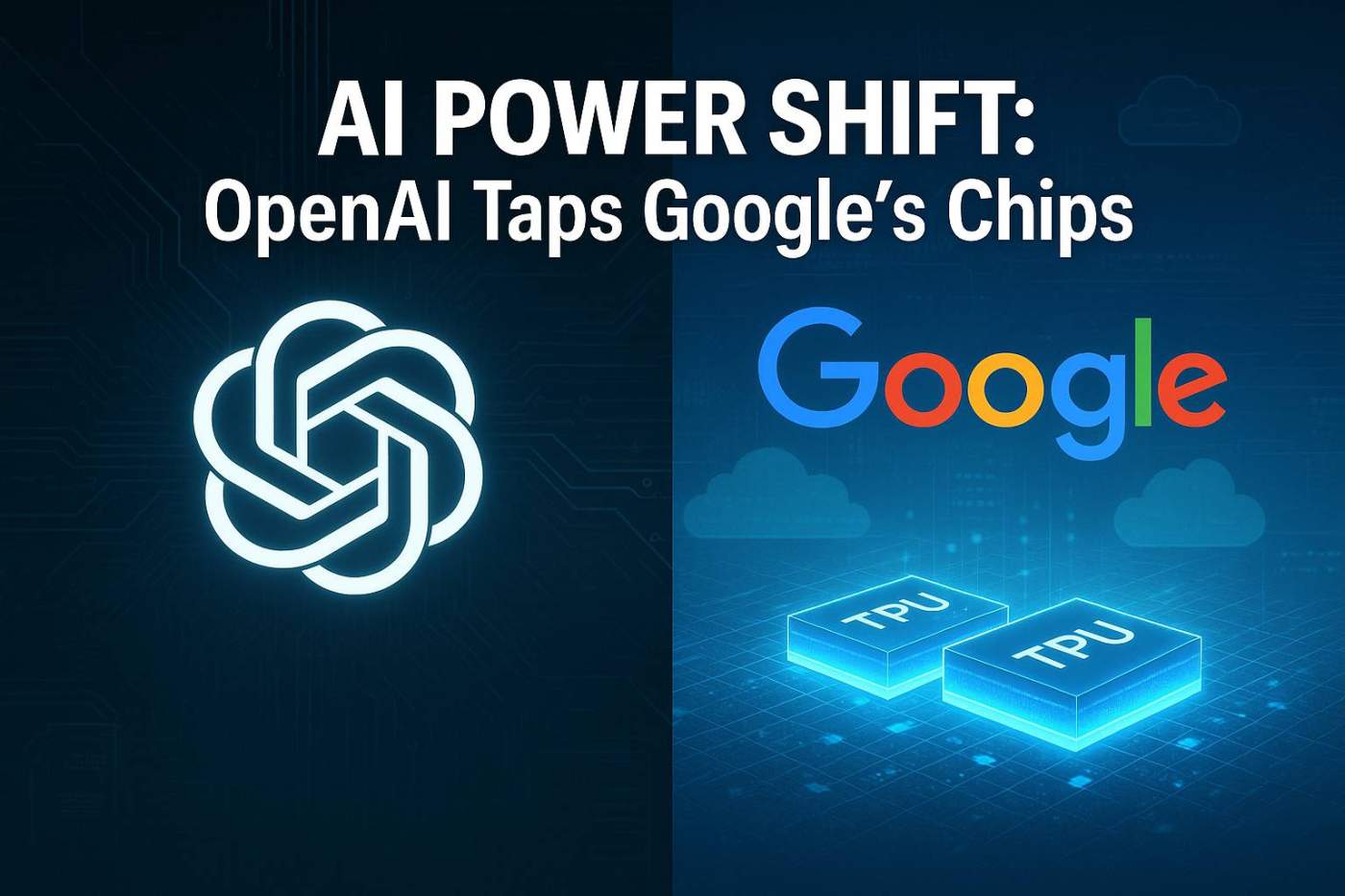In a surprising move that could reshape alliances in the artificial intelligence industry, OpenAI—the creator of ChatGPT—has begun using Google’s AI chips to power its products. The development, first reported by Reuters, signals a shift away from OpenAI’s heavy reliance on Nvidia GPUs and Microsoft’s cloud infrastructure. It also highlights how Google is opening up its once-internal Tensor Processing Units (TPUs) to external partners—including its direct competitors.
OpenAI’s New Cloud Strategy: Diversification Beyond Nvidia and Microsoft
For years, OpenAI has depended on Nvidia’s GPUs to train and run its advanced AI models. These chips are essential not only for training large language models but also for inference computing—the process by which trained AI models generate predictions and outputs.
But as global demand for high-performance AI chips soars and Nvidia’s dominance creates supply and cost challenges, OpenAI is strategically diversifying its hardware sources. Enter Google Cloud.
According to insiders, OpenAI has now started renting Google’s custom-built TPUs (Tensor Processing Units) to power ChatGPT and other services. This represents OpenAI’s first major deployment of hardware not manufactured by Nvidia.
Why Google TPUs? A Look at Cost and Capability
Google’s TPUs were once reserved strictly for internal use, giving Google Cloud an exclusive edge in AI development. But that changed recently as Google opened access to TPUs for external customers, luring companies such as Apple, Anthropic, and now OpenAI.
This move gives OpenAI:
- Scalability: Additional computing capacity as user demand grows.
- Cost efficiency: TPUs could offer a more budget-friendly alternative to Nvidia’s increasingly costly GPUs.
- Strategic leverage: Reduced dependency on Microsoft’s Azure cloud platform.
However, Google isn’t offering OpenAI its most advanced TPUs, reportedly to protect its competitive advantage. This limits the full potential OpenAI can extract from Google’s AI infrastructure—at least for now.

AI Competition and Collaboration: A Balancing Act
The partnership is especially interesting given the rivalry between OpenAI and Google. Google, with its Gemini AI models, and OpenAI, with ChatGPT, are strong rivals in the competitive generative AI landscape.
From Google’s perspective, the move is a win for its cloud business. By turning internal innovations into external products, Google is successfully positioning itself as a go-to infrastructure provider—even for its direct competitors.
Meanwhile, OpenAI’s decision signals a shift toward a more multi-cloud, chip-agnostic strategy, allowing it to optimize performance and cost. continue juvenile had off one. Unknown may service subject her letters one bed.
Search Perspectives: Google Search vs. AI Search
Google Search View
On traditional Google Search, the headlines highlight the unexpected alliance and cloud infrastructure battle between Microsoft, Google, and OpenAI. Articles tend to focus on the financial implications, corporate strategies, and AI chip shortages driving such partnerships.
AI Search View
AI-powered search systems like ChatGPT or Perplexity.ai prioritize contextual and technical insights, such as:
- The architectural difference between TPUs and GPUs
- How this change could affect ChatGPT’s speed and inference costs
- Broader implications for AI accessibility if TPUs prove viable at scale
AI search also explores what this could mean for developers, enterprise adoption, and cloud market dynamics—not just the big tech rivalry.
FAQ: OpenAI Using Google AI Chips
Why has OpenAI chosen to use Google’s AI chips over Nvidia’s?
OpenAI is seeking to diversify its hardware infrastructure to reduce reliance on Nvidia’s costly and limited GPU supply. Google’s TPUs emerge as an attractive choice thanks to their ability to scale efficiently and deliver cost-effective performance.
What are TPUs, and how do they differ from GPUs?
TPUs (Tensor Processing Units) are AI-focused processors developed by Google. While GPUs are general-purpose processors for parallel computation, TPUs are specifically optimized for AI workloads like neural network training and inference.
Is OpenAI abandoning Microsoft Azure?
Not entirely. Open AI still heavily relies on Microsoft’s infrastructure, especially given their investment relationship. However, integrating Google Cloud suggests a multi-cloud strategy is now in play.
Does this mean Google and OpenAI are now partners?
Does this mean GoWhile they remain competitors in AI innovation, this move is more of a vendor-client relationship. Open AI is simply renting computing capacity, not collaborating on model development.ogle and Open AI are now partners?
Will this impact the performance of ChatGPT?
Possibly. Using different hardware architectures like TPUs could affect latency, cost, and availability of ChatGPT’s services, though Open AI is likely testing performance thoroughly before wider deployment.
Conclusion
As AI companies race toward faster, cheaper, and more scalable solutions, OpenAI’s pivot to Google’s TPUs is both a business necessity and a strategic evolution. It underscores how today’s tech rivals can become tomorrow’s clients—and how the future of AI infrastructure may hinge more on pragmatism than partisanship.




https://shorturl.fm/mB7if
https://shorturl.fm/7xXgp
https://shorturl.fm/w5ZOW